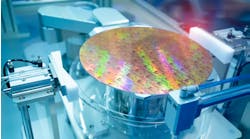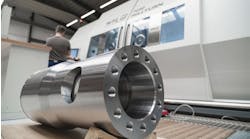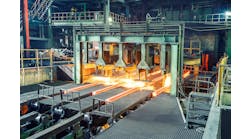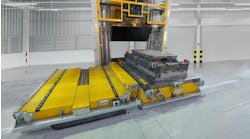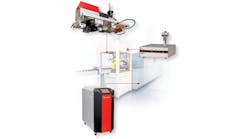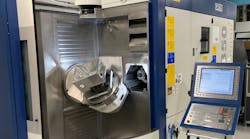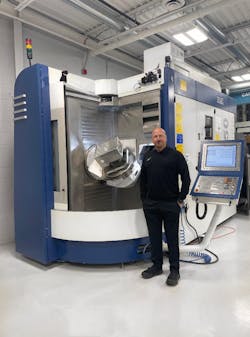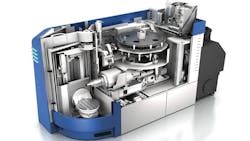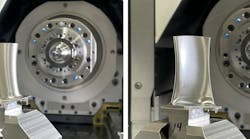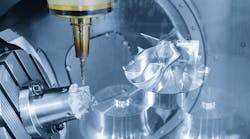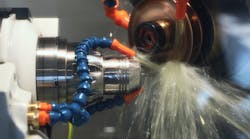Latest from Machine Tools & Metal Working
Universal Machining Center Helps Machine Supplier Meet Tight Tolerances
Advanced Precision Engineering, Inc. (APE) is a leading supplier of complex machined parts, assemblies, and kits to the medical, aerospace, military, automation, and semi-conductor industries.
When APE landed a project for new housing that goes into medical diagnostics equipment, they went looking for a machining center that could handle the serious amount of hogging out the end part required.
They opted for a 5-axis universal machining center that ensured proper chip evacuation, held extremely tight tolerances, and kept vibration to a minimum.
The Search for the Right Machine
Working with materials ranging from aluminum to specialty alloys, APE integrates a diverse product base into a variety of platforms for prominent original equipment manufacturers.
Known for super high accuracy, APE’s customer base includes Lockheed, Raytheon, and Boeing.
Anticipating the need for a horizontal spindle 5-axis machine for one or more of their medical customers, APE had started its search nearly four years ago, waiting for the right project to come along to pull the trigger.
“We have 37 high-speed machining centers, and in the past, everything we had done was satisfied by our existing 5-axis machines, which all feature vertical spindles,” said Alan Soucy, President and CEO.
But the new medical housing part was different.
Starting with 165 pounds of material, the end part weighs in at just 36 pounds. This tremendous amount of hogging out can cause issues with chip evacuation.
They began looking for a machine with a horizontal spindle, which would allow them to flip the part 180 degrees in the work environment, making it easier for the chips to fall down and be removed by the chip conveyor.
Soucy’s thinking was that if they were going to be using a new horizontal 5-axis machine, they wanted to do it right. They began by reviewing their existing stable of machines and discussed what brands they might be comfortable with.
Their other high-speed machining centers use HEIDENHAIN CNC controls, which Soucy calls the “gold standard” for 5-axis machines—light years ahead of other options in terms of ease of use.
Because APE likes to lock in when they choose a control for a particular type of milling or turning machine, they focused the search on horizontal 5-axis machines using HEIDENHAIN controls.
“We needed multiple operators and engineers to be trained on the controls so anyone could operate any of the 5-axis machines.”
That search culminated in the selection of a G350 5-Axis Universal Machining Center, manufactured by GROB Systems.
The G350 features three linear and two rotary axes, giving operators 5-axis simultaneous machining and simultaneous interpolation. The axis arrangement facilitates upside-down machining, and the horizontal spindle position ensures the longest possible Z-travel path and optimum chip fall.
Manufacturing Facility Reflects Serious Reliability
Soucy originally saw the machine at International Manufacturing Technology Show. Four years ago, he traveled to GROB’s Bluffton, Ohio manufacturing facility, two years before they bought the machine.
“I needed to see the machines in person, so I flew there and toured the facility, which blew me away,” extolls Soucy.
“Every owner should get a tour to see what is behind the manufacturing of these machines. The way they operate and how they train apprentices is inspiring. They show how each apprentice starts out in the company and how they move along, so they know everything about the machines they are building. It's an impressive facility and I had an 'aha' moment—I knew I would buy one when the right job came up.”
Soucy is also gratified that their machine is one of the first-ever made in the U.S. to use the HEIDENHAIN controls.
In addition to being impressed with the factory, Soucy also reasoned that GROB’s long and successful history of work in the auto industry translates into serious reliability. In fact, reliability was the main reason they were always looking for GROB equipment.
Soucy also has nothing but praise for the machine installation.
“They came on a truck and everything was in one unit, including the chip conveyor. The only thing not fully assembled was the chiller unit. Usually, a machine has a ton of options, each arriving separately, for example, mist collectors. With our machine, this one fork truck picked up the whole machine and the only thing left to connect was the chiller. Then we had two weeks of validating and commissioning the machine. The people they sent were spot-on knowledgeable.”
Speaking of reliability, Soucy notes that several people tried to dissuade him from purchasing the G350, saying that the welded frame is not as robust or as heavy as a cast-iron machine and that this would result in too much vibration.
During the factory tour, Soucy gained confidence in how the machine is built. He says, “I asked myself, is there any truth to the problem with welded frame construction?” He found none at all. “There is no vibration—all you are hearing is that smooth sweet cutting sound.”
Another positive feature is GROB’s ability to log in remotely to tune the machines. For example, the weight in the housing on the table offsets so dramatically that sometimes when the rotary and tilt want to move at high velocity, it gives feedback. In that case, GROB logs in and tunes the machine in 30 minutes.
Because the G350 uses the same HEIDENHAIN controls as its other 5-axis machines, the company could hit the ground running without much training. Before they purchased the G350, machining took six operations for this part. The new machine took it down to two operations plus an offline dovetail prep operation to hold the part.
It used to be done on a horizontal 4-axis machine and now it is done on the 5-axis machine. So, instead of having to flip the part and re-fixture, they can hold the part on the dovetail and rough out the part and relax, then finish without removing it because they are able to hit 5 sides of the part at once.
Behind the Hood
The G350 has a unique arrangement of the three linear axes, which minimizes the distance between the guides and the machining point (TCP), lending the machine considerable stability.
The full tool length can be employed in any axis position, even with maximum part size. Even with extremely long tools operators can swivel and machine the largest possible component within the work area without collision.
With a swivel range of 230 degrees on the A-axis and 360 degrees on the B-axis, the G350 offers the greatest possible positioning flexibility, while the machine bed’s intrinsically stiff welded design delivers optimum machine rigidity.
The G350 also features absolute position encoders, an air purge seal in all linear and rotary axes, and a disk-type tool magazine for fast tool change.
The central, ergonomic arrangement of the machine components guarantees optimal accessibility to the fluid cabinet and electrical cabinet, as well as easy access for preventive maintenance and inspection.
Efficiency Savings and Impressive Accuracy
With an ultimate goal of integrating four machines into a 100-palletized system with a pallet changer running seven days a week, APE began with one single machine to make sure it would perform as envisioned. The company plans to add 20,000 square feet to its existing facility and the machine will be placed there.
In addition to running the new medical housing job, the G350 will be used for critical housing in the missile/defense industry.
Other plans for the G350 include handling new business, as well as taking some jobs that are currently running elsewhere and automating them.
According to Soucy, the spindle reliability is impressive, providing great accuracy. “The medical device housing we are using the machine for has a lot of tight tolerances and the only change we see is due to tool wear. The machine is spot on, as accurate as our other 5-axis machines, and it meets our very high bar.”

